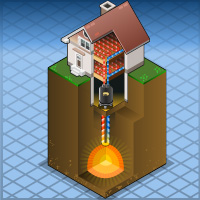Did you know that your backyard can be a source of heating and cooling for your home? Geothermal technology allows a water-based solution to travel through loops in the ground to access heat energy absorbed by the Earth. Cost savings and energy efficiency are two reasons to choose geothermal technology.
Positive Cash Flow
A geothermal system presents expensive up-front costs, but energy savings, higher property values, and more economical energy costs mean that you pay less long-term.
Heating Cycle
The system works by forcing fluid through loops where they draw heat from the ground and transfer it to a geothermal unit. The unit compresses the heat to a high temperature and delivers it throughout your home.
Cooling Cycle
During a cooling cycle, the process above is reversed. The earth is cooler than the air on a hot day, so the geothermal system removes heat from the home and puts it into the ground. The fluid is cooled by the ground temperatures and returned to the unit for cooling your home.
The Heart of the System: Geothermal Loops
A loop system is the heart of geothermal technology. Regardless of the option you select, installing a geothermal loop system is like obtaining a 70% discount on energy for the life of your home.
Vertical Loop: This loop is used mainly when land area is limited and in retrofit applications of existing homes. A drilling rig is used to bore holes at of depth of 150 to 200 feet. A U-shaped coil of high density pipe is inserted into the bore hole. The holes are then backfilled with a sealing solution.
Horizontal Loop: The horizontal loop is the most common one for situations where adequate land area is available for use. Loop installers use excavation equipment such as chain trenchers, backhoes and track hoes to dig trenches approximately 6-8 feet deep. Trench lengths range from 100 to 300 feet, depending on the loop design and application.
Pond Loop: A pond loop is an option if a large body of water is available within approximately 200 feet of the home. A half-acre, eight to ten foot deep body of water is usually adequate to support the typical home. The system uses coils of pipe that are typically 300 to 500 feet in length. The coils are placed in, and anchored, at the bottom of the body of water.
Open Loop: An open loop system may be an option if a sufficient supply of high quality well water is available. The average home will require four to eight gallons of water per minute. A proper discharge area such as a river, drainage ditch, field tile, stream, pond, or lake must be present. Check your local codes for restrictions before selecting a specific discharge method.
- Non-Ozone depleting R-410A refrigerant
- Bolted together cabinets, not screwed
- All panels removable for easy service
- Coated air coils for extended life
- Bidirectional expansion valve
- 5 year limited residential warranty with 10 year compressor warranty
- ETL certified to UL & CSA standards
- AHRI certified to ISO standards
- Copper coaxial water heat exchanger
- Variable speed ECM blower motors
- Flow switch protected
- Fault retry to eliminate nuisance service calls
- High efficiency Copeland® scroll compressors
